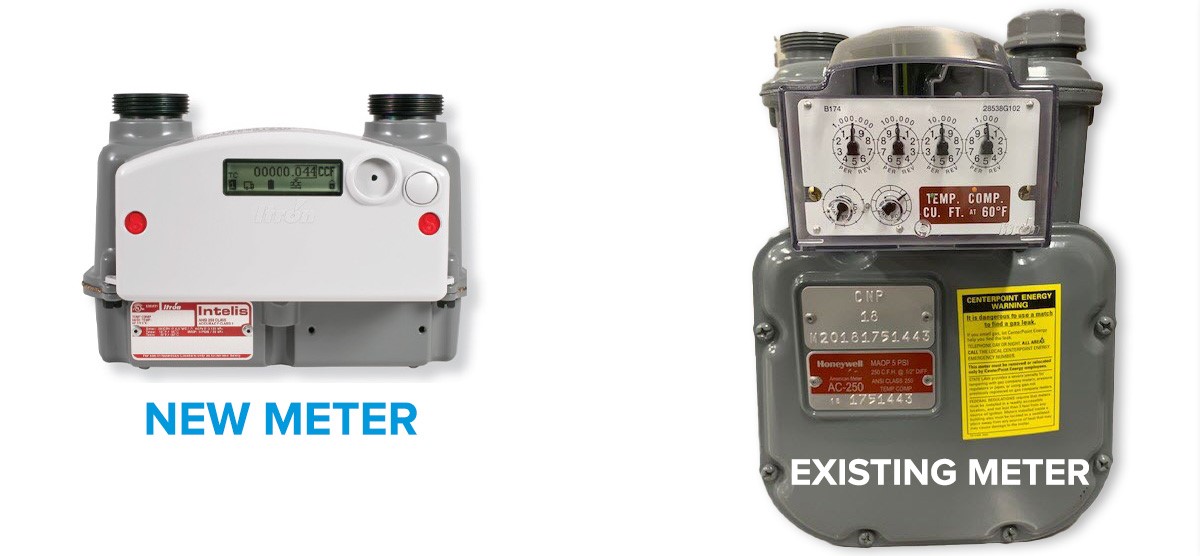Natural Gas Meter Installation
Guidelines
When a buyer's decision can come down to curb appeal, maintaining an aesthetically appealing exterior is critical for builders and developers. By offering several different meter placement options, CenterPoint Energy helps builders and developers add value to their buildings. Contact your CenterPoint Energy Sales Consultant or Construction Services for meter requests or questions: 612-342-5123 or 800-342-4166.
Individual meters
This traditional option is still available, but use is declining as codes requiring more vents and air intakes often conflict with homeowner demands for clutter-free entrances that look clean and beautiful.

CenterPoint Energy is now installing the new Itron Intelis gas meter. This meter has a variety of cutting-edge technology features including:
- Compact size to facilitate installation and improve aesthetics
- Integrated safety shutoff valve
- High-temperature sensor and alarm
- Embedded radio frequency communication
- High-flow and air-detection alarms
- Reverse-flow detection
Banked meters
Placing multiple meters together (a bank of meters) on a side wall can cost effectively give a building a clean, clutter-free exterior. 
A meter bank allows meters to be placed on a sidewall and hidden from the street. Meter banks can easily be hidden with landscaping or fencing to help offer more curb appeal.
With proper ventilation and access, meter banks may also be enclosed for an even cleaner look.
 |
|
Meter banks can be fully enclosed, as long as utility workers have direct access and proper ventilation is added to meet code requirements. Floor must be dirt for access. |
NOTE: Meter banks require direct access for gas utility personnel and cannot be fully enclosed without adding proper direct ventilation. Also, depending on building type, public utility easement verbiage may need to be added to Association Documents to allow for one service line to service multiple meters and for internal piping to cross ownership lines.
Meter alcoves
This option allows for individual meters to be set and hidden from the street. Because meter alcoves meet aesthetic needs as well as simplify utility coordination for the builder or developer, this has become an increasingly popular option.
 |
|
Hiding meters in an alcove helps maintain an aesthetically pleasing exterior while still allowing utility workers full access to the meters. No additional ventilation is required. |
Note code requirements for meter alcoves.
- Alcove must be at least 3' wide and be deep enough to set both gas and electric meters (minimum 12').
- Must maintain the minimum clearance of 3' between the meter relief valve and the electric meter.
- Floor must be dirt to allow access to underground piping.
Location requirements for meter installation (May vary by city)
- 3' from fresh air intake or any opening to building
- 3' from doors or operating windows
- 3' from water spigots
- 3' from any ignition source
- Away from driveway or vehicle traffic
- Avoid locations directly below roof valleys, water downspouts, decks, stairs, or partial overhangs
- Banked meters are preferable for townhouse or multi-unit buildings
- Regulator and relief valve must be located where gas can escape freely away from any opening into the building
- Must have all exterior walls framed before meter can be installed. If changes are made after meter installation and meter no longer meets codes, you will be charged to move the meter
Meter protection/Guard posts
When the only option is to install a meter on the front of a garage or where it may be exposed to vehicle damage, building codes require that concrete-filled guard posts be installed at the builder's expense.
Guard posts must be:
- 4" diameter steel posts filled with concrete
- On a 15" diameter concrete footing, 3' deep and 3' above grade
- Placed no greater than 4' apart and not closer than 3' from meter set
Cost of installation:
- 5 or more posts $262 each
- 4 Posts - $1068
- 3 Posts - $988
- 2 Posts - $765
- 1 Post - $388
| |
Costs for guard posts installed November 1 through March 31 will be time and material.
 |
|
When individual meters are set on the fronts of garages or anywhere they can be subject to damage from vehicles, codes require guard posts be installed for protection, which can be costly for the builder. |